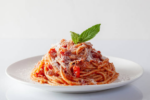Making your own pasta from scratch can potentially save you money compared to buying dried pasta at the grocery store.
Homemade pasta typically costs around $0.50 to $1.00 per pound to make, while store bought dried pasta ranges from $1 to $2 per pound. The key ingredients for homemade pasta – flour, eggs and oil – are fairly inexpensive kitchen staples. With just a rolling pin or inexpensive pasta machine, you can turn those basic components into fresh pasta costing at least half the price of boxed varieties. Over time, the savings from making your own pasta in large batches can really add up and potentially extend your overall food budget.
Cost Comparison
Homemade pasta is generally cheaper than store bought dried pasta, often costing around half the price per pound. The cost comparison between the two options breaks down like this:
Store pasta typically ranges between $1 to $2 per pound, depending on the brand and shape. Even value brands usually start at around $1 per 12 ounce box, or $1.50 per pound.
Homemade pasta, on the other hand, usually costs between $0.50 to $1.00 per pound to make from scratch depending on ingredient prices. The key components – flour, eggs and oil – are fairly low-cost.
This means that for every pound of pasta you make at home, you can potentially save $0.50 to $1.50 compared to buying an equivalent amount of store pasta. For a standard 2 pound batch of homemade linguine or fettuccine, that amounts to savings of $1 to $3. And if you double the recipe to make 4 pounds, now you’ve saved $2 to $6 just by making your own pasta.
In short, the primary ingredients for homemade pasta – flour, eggs and oil – are inexpensive enough that they typically end up costing half to two-thirds the price of one pound of dried pasta from the store. With simple homemade pasta recipes, you have the potential to significantly reduce your pasta budget over time.
Ingredients
Flour – The main ingredient, usually all-purpose flour. A 4 cup serving will typically make around 1 pound of pasta. The cost for 1 pound of flour ranges from $0.30 – $0.60 depending on the brand.
Eggs – Eggs help bind the dough and give fresh pasta its rich, yellow color. Most recipes call for 2-3 large eggs. At around $0.50 each, 2-3 eggs will cost around $1 for the ingredients for 1 pound of pasta.
Olive oil – A tablespoon or two of olive oil is commonly added to homemade pasta dough to help prevent sticking. The cost is minimal, around $0.50 for the oil required for a pound of pasta.
Salt – A teaspoon or two of salt seasons the pasta dough and enhances the flavor. The cost of salt for a recipe yielding 1-2 pounds of pasta is just pennies.
Together, these basic homemade pasta ingredients will typically cost between $0.50 to $1.00 per pound. Even using higher-end ingredients like organic flour and olive oil, the cost is unlikely to exceed $1.50 per pound for the components. In contrast, store bought dried pasta will commonly run from $1 to $2 per pound or more.
So while homemade pasta requires a bit more work, the simple ingredient list of flour, eggs, oil and salt ensures it will nearly always be more budget-friendly compared to buying dried pasta boxes. The cost savings really add up when making multiple batches at a time.
Equipment
The equipment required to make fresh pasta at home is quite minimal:
- Rolling pin – A wooden or metal rolling pin is essential for rolling out the pasta dough by hand. Rolling pins range in price from around $10 to $30.
- Pasta machine (optional) – A manual pasta machine allows you to roll the dough into uniform thin sheets with precise thickness settings. Pasta machines cost $40 and up.
- Rolling board – A flat, wooden board or long cutting board provides a sturdy surface for rolling out pasta dough by hand. Boards range from around $10 to $30.
- Basic tools – A few other basic kitchen tools are needed to make pasta: A large bowl or mixing bowl for mixing ingredients, a fork or whisk for beating eggs, and a knife for slicing or cutting pasta shapes.
While a pasta maker can speed up the process and produce more consistent pasta sheets, homemade pasta can easily be made using just a rolling pin and a rolling board or cutting board. The cost of essential equipment – a rolling pin and cutting board – starts at around $20 and up.
So for under $50, and often less than $30 spent on basic equipment, you have everything required at home to make your own fresh pasta and potentially save 50% or more compared to the cost of store bought dried pasta varieties.
Batch Yield
A standard batch of homemade pasta dough will typically yield around 1.5 to 2 pounds of fresh pasta and costs around the following:
Ingredients for 1 pound of pasta:
- 2 to 3 cups all-purpose flour – $0.30 to $0.60
- 2 large eggs – $0.50
- 1 tablespoon olive oil – $0.10
- Pinch of salt – $0.05
Total cost for 1 lb batch: $0.95 to $1.25
A 1 pound batch of homemade pasta will actually yield around 1.5 to 2 lbs of pasta once rolled out and shaped into noodles. This is because the dough absorbs a portion of the flour during mixing and resting.
So a batch that costs around $1.00 for the ingredients will actually yield:
- 1.5 lbs of pasta for around $0.67 per pound
- 2 lbs of pasta for around $0.50 per pound
This means that for just over $1.00 worth of ingredients, you can end up with $2 to $3 worth of store bought dried pasta.
The recipe can also easily be doubled or tripled to make even more cost savings:
- A 3 lb batch would cost around $2.00 for the ingredients but yield the equivalent of $3 to $6 worth of boxed pasta
- A 4 lb batch for around $2.50 in ingredients would match $4 to $8 worth of dried pasta from the store
The larger the batch of homemade pasta you make at once, freezing portions, the greater the potential long term savings versus buying dried pasta at the grocery store. All from a simple recipe using flour, eggs, oil and salt already found in most kitchens.
Long-Term Savings
Making homemade pasta in larger batches can really add up in cost savings over time:
- Pasta machines pay for themselves – While not strictly necessary, a manual pasta machine allows you to quickly and easily roll out flat pasta sheets with precise thicknesses. For around $40 to $100, a pasta maker will quickly “pay for itself” in the form of reduced pasta spending.
- Staple ingredients – The key components for making pasta – flour, eggs, and oil – are likely already found in most kitchens as staple baking and cooking ingredients. They require little additional expense for homemade pasta production.
- Extends your food budget – The money you save each time you make a big batch of homemade pasta instead of buying a comparable amount from the store adds up over weeks and months. Those savings can stretch your overall food budget and Monthly grocery costs.
- Reduces waste – Store bought dried pasta often has a longer shelf life, but it does eventually go stale if unopened for many months. Homemade pasta is best consumed within a week, minimizing waste from boxes left uneaten for too long.
For example:
- Making just one 4 pound batch of pasta, saving $5-8 compared to store bought, and repeating that once a month for a year could collectively save you over $100.
- If you make that same 4 pound batch every other week, doubling the frequency, the annual savings increases to over $200 just from making fresh pasta at home.
- And if you were to buy a $40 pasta machine to aid in production, it would potentially “pay for itself” after just 2 to 3 large homemade pasta batches.
Over the long term, the cost savings from making larger batches of homemade pasta from basic pantry ingredients really builds up and can measurably extend your monthly food budget. When combined with freezing portions of the pasta for later use, homemade is often a significantly more budget-friendly option versus store bought dried pasta varieties.
In summary, making your own pasta from scratch at home has the potential to greatly reduce your overall pasta costs compared to buying dried pasta boxes from the grocery store. The basic ingredients required for fresh pasta – flour, eggs and oil – are fairly inexpensive kitchen staples. With just a rolling pin or inexpensive pasta machine, you can turn those components into pasta costing at least half the price of store bought pasta. While the savings from an individual batch may be modest, over time the cost difference really adds up, helping to extend your overall food budget. Making larger batches of homemade pasta and freezing portions allows you to maximize your savings versus regular pasta purchases.
FAQs
1. How much does fresh pasta cost?
Homemade pasta typically costs between $0.50 to $1.00 per pound to make depending on ingredient prices.
2. Can you make pasta without a machine?
Yes, homemade pasta can easily be made using just a rolling pin on a flat surface like a cutting board. A pasta machine just speeds up the process.
3. Can you substitute semolina for all-purpose flour in pasta?
Semolina flour can be substituted for all or part of the all-purpose flour in pasta dough recipes. It will yield a slightly firmer texture.
4. Does homemade pasta last longer than store bought?
No, fresh homemade pasta typically lasts 3 to 4 days in the refrigerator while dried pasta can sit on the shelf for 1 year or more.
5. What lasts longer pasta or flour?
Dried pasta typically has a much longer shelf life of 1 year or more, while all-purpose flour generally lasts 6 to 12 months when stored properly.




